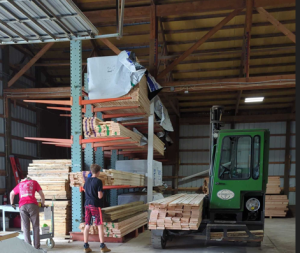Dear Readers: For those of you missing the past two days, or yesterday’s blog at most, please back up a day or two to bring you up to speed for my response to a seemingly heated rejoinder by Mike Burkholder of Ohio Timberland Products to a blog I wrote. This is published in it’s entirety.
Dear Mr. Burkholder ~
Thank you very much for your comment response to my blog article on nail laminated columns. I’m humbled someone with your extensive bac kground and experience would take the time from their busy schedule to write.
kground and experience would take the time from their busy schedule to write.
On an all-too-frequent basis we are asked by clients to compare the Hansen Pole Building against those who profess to be offering the same or better. Sadly, there are resellers of the Nail-Lam “PLUS” columns, manufactured by your company – Ohio Timberland Products, Inc., who are promoting the columns as being glu-laminated columns. Your website (www.ohiotimberland.com) clearly delineates your products as being nail-laminated, leaving the question to be are the resellers confused about the columns you manufacture, or is it a deliberate misrepresentation on their part?
From the information provided on your website, if a client told me they had to have a nail-laminated column, there is more than a fair chance I would recommend your product over any others for two reasons.
Number One – the structural finger joint between the upper and lower portions of the column. I’ve been told, by more than one glu-lam manufacturer, of the finger joint being the toughest part of the process to get right, and it appears you have “glued it” (as opposed to “nailed it”). The structural finger joint has to be a huge strength step up from non-reinforced butt end splices, flat steel plates or even “gang nail” style plating.
Number Two – your use of a through mechanical fastener, as opposed to just nailing, to join the individual plies. I began fabricating nail laminated columns at my first business about 30 years ago. When we had them tested at the Oregon State University Forest Products lab, we found nearly every failure came from the middle ply – because it had twice the number of nails into it (as the nailing was from both sides, into the middle member). Your superior fastening method creates a far more even load distribution across the members.
In my humble opinion, these two features alone should be able to be presented as benefits to the end user which should sway anyone who is considering a nail-lam to yours, regardless of the price point.
Possibly without realizing it you have your foot in the door at Hansen Pole Buildings, for a tremendous selling opportunity. We’ve always endeavored to offer to our clients the best possible value for their post frame building investment. All you need to do is provide a preponderance of evidence supporting the benefits to the ultimate end user of your product – the building owner. I’d encourage you (or one of your sales team) to contact Eric Graff, the managing partner of Hansen Pole Buildings, to make a presentation.
I personally will extend to you this offer – you are invited to guest blog about your Nail-Lam “PLUS” columns and I will run your offering verbatim, with small caveats. It should be written to the end user (again, the building owner) and extoll the benefits to them (not merely features). Any claims of superiority should be backed up by factual proof (e.g. testing results). And – once your article is published, a link to it is added on your website.
For my own curiosity I do have a couple of questions, which I am relatively certain you can easily answer.
If I am not mistaken, you testified before ALSC (American Lumber Standards Committee)in 2012 regarding design values for visually graded SYP. This effort resulted in your landing on the SPIB (Southern Pine Inspection Bureau) T&R Committee. This might lead me to believe you are pretty much an expert when it comes to the use of Southern Pine.
In looking at the design value table presented on https://ohiotimberland.com/literature_zoom.html I see an “E” value presented of 1,700,000. When I look at https://www.southernpine.com/app/uploads/200N_NDV_tables1-2_2013_L.pdf effective June 1, 2013 the “E” value for No. 1 Southern Pine is 1,600,000. I can only surmise this is a resultant of actual product testing, or my unfamiliarity with the intricacies of the NDS. The same would apply to deriving an Fb value of 1897 psi (for a multiple 2×6 product) from a base value of 1350 psi.
I’m always striving to learn more and would appreciate it if you could take the time to educate me on this.
The other would be (from your website), “adhesive between plys greatly cuts down on interlayer slip resulting in better weak-axis stiffness”. If you could share with me the testing results on this, I’d be very interested in reviewing them. I can see how this could be a benefit (provided the stiffness is adequate) in being able to utilize the columns in an unbraced situation such as open side sheds, etc.
Again, thank you very much for your time and I will look forward to hearing from you in the near future.
Best regards ~
Mike, The Pole Barn Guru
 On their website (
On their website (




